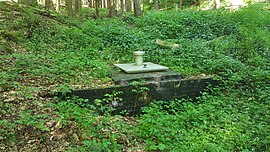Pit of Blessed Hope
| Blessed Hope | |||
|---|---|---|---|
| General information about the mine | |||
| Mining technology | Civil engineering | ||
| Rare minerals | Malachite , azurite , copper gravel | ||
| Information about the mining company | |||
| Start of operation | 1737 | ||
| End of operation | 1747, operations were later resumed with the Old Hope until after the First World War | ||
| Funded raw materials | |||
| Degradation of | copper | ||
| Geographical location | |||
| Coordinates | 50 ° 43 '26.4 " N , 8 ° 11' 36.1" E | ||
|
|||
| Location | Langenaubach | ||
| local community | Haiger | ||
| country | State of Hesse | ||
| Country | Germany | ||
| District | Dillenburg mountain area | ||
The Blessed Hope mine was a copper mine near Langenaubach ( Haiger municipality ) in the Lahn-Dill district . The pit lay between Langenaubach and Haiger in the lower Lehmbachtal . Copper was mined from at least 1737. In 1789, Becher wrote that the mine had been out of service for more than 30 years and was promising in its time. From 1737 to 1749 the mine delivered a total of 2,356.65 quintals of ore to the Isabellenhütte near Dillenburg, from which 558 quintals of copper were extracted. In 1749, the tunnel length is said to have been 50 laughers (1 laugher = approx. 2 meters). A few years earlier they had crossed an ore which, in polite cracks, would have thrown 30 laughs into the field. When the weather broke in the pit , but the tunnel turned out to be in the middle of the mountain, a new tunnel was set up on it and with this, after 15 puddles, an ore vein that was also 2 feet thick was encountered. Both tunnels were then cut through and so much ore was mined that 5,376 guilders were yielded in 4.5 years . As a result, however, the corridors had become unworkable , with 50 piles of the upper tunnel being driven away and 70 piles of the lower tunnel being driven away . So the mine fell into recession and lay where it was because the trades refused to pay the additional penalties . Becher criticizes this approach and complains that the 30 Lachter long noble corridor was not sunk. Before 1789, the Blessed Hope was consolidated with the old hope pit located higher up in the Lehmbachtal .
In 1867 Odernheimer reported on the Alte Hope mine , which was probably still consolidated with the Blessed Hope that there were two ore veins, the Lembach vein ( quartz-like and up to 3 ″ thick) and the Altenhoffnungsgang (late), on which the pit leading to the At that time it had been out of service for a long time. The deep tunnel had a length of 140 pools (approx. 280 m) and a depth of 12 pools. 110 laughs are said to have come up on the first course and about 90 laughs on the last. The salmon salmon walk was known for a length of 300 laughs and raised to 50 laughs on the upper level. This is probably why the deep lembach tunnel was created, which in 1867 had a length of 100 pools and was supposed to cut the vein at 120 pools. The depth at this length of tunnel would be 40 peaks. At this point only the deep Lembach tunnel of the former 5 tunnels is said to have been open. At Odernheimer, the deep lembach tunnel is probably the deep tunnel of the Blessed Hope pit . There is no other explanation for the notice that has been out of service for a long time together with the reference that the deep tunnel has to be driven further and is open. In addition to the vein name Lembachsgang, which characterizes the vein of the Blessed Hope, the fact that Odernheimer states that mining began in 1737, which corresponds to the earliest documented start of mining for the Blessed Hope mine . Confusion in the descriptions due to the consolidation that has taken place seems obvious.

Ernst Frohwein reported in 1885 that the 350 m long exposed, up to 1 m thick Altehoffnungsgang, in the bottom of the gallery at a depth of 40 m, was mined to the extent that it was ore-bearing. It is reported that the Lembach dike, which is also up to 1 m thick, is open to a length of 350 m in the aforementioned tunnel floor and was excavated to a depth of 70 m underground to a length of 50 m by means of a die , where this passage joins the Altehoffnungsgang schaart. He also writes that a similar corridor touches down 600 m to the northwest, which seems to be the continuation of the Lembach corridor. This was crossed to 100 m and has so far been dismantled to a depth of 20 m.
Operations were suspended in the 19th century and resumed in the 20th century. After the First World War, the Alte Hope mine was permanently shut down. Today you can still see the (deep) tunnel or shaft cover of the Blessed Hope pit, as well as a larger spoil dump on which copper pebbles can be found.
See also
Individual evidence
- ↑ Mineral Atlas : Old Hope Pit
- ^ A b Johann Philipp Becher: Mineralogical description of the Oranien-Nassauische Lande: together with a history of the Siegen smelting and hammering industry . 1789.
- ↑ F. Odernheimer: The mining and metallurgical industry in the Duchy of Nassau: statist. News, geognost., Mineralog. u. techn. Descriptions d. Deposits of usable minerals, d. Mining u. Ironworks . tape 1 . CW Kreidels, Wiesbaden 1867.

